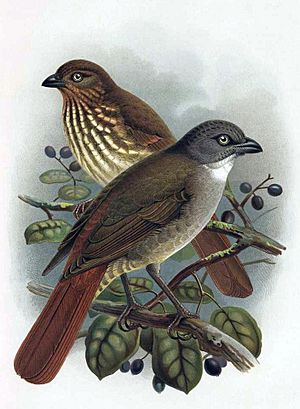North Island piopio facts for kids
Quick facts for kids North Island piopio |
|
|---|---|
 |
|
| North Island piopio in front, South Island piopio at rear. | |
| Conservation status | |
| Scientific classification | |
| Genus: |
Turnagra
|
| Species: |
tanagra
|
| Synonyms | |
|
|
The North Island piopio (Turnagra tanagra) was a type of passerine bird, which means it was a perching bird, like a sparrow or a robin. It belonged to the family Oriolidae. Sadly, the North Island piopio is now considered extinct, meaning there are no more left in the world.
About the Piopio's Family
For many years, people thought the North Island piopio was the same species as the South Island piopio. However, scientists later discovered they were two different species. They looked closely at their bodies and bones (this is called osteology) and found clear differences. Another name for the North Island piopio was the North Island thrush.
Why the Piopio Disappeared
The North Island piopio lived only on the North Island of New Zealand. In 1873, a scientist named Walter Buller said the bird was common. But after that, its numbers dropped very quickly.
Scientists believe the last piopio specimens were collected around 1885 or 1886, though some records suggest 1900. By the 1960s, only about 27 piopio specimens were left in museums around the world. Some people reported seeing the bird as late as 1970, but it is now officially extinct.
The piopio's last known home was an area that is now Whanganui National Park. It might have also lived northeast towards the Hauhungaroa Range, west of Lake Taupo.
The main reason the North Island piopio died out was the introduction of new animals to New Zealand. Animals like cats and rats, which were brought by people, hunted the piopio. Losing their natural home (habitat loss) and being hunted by other animals like mustelids (which include stoats and ferrets) also played a big part in their disappearance from the 1880s onwards.
Images for kids
-
North Island piopio in front, South Island piopio at rear.
See also
 In Spanish: Piopio de isla Norte para niños
In Spanish: Piopio de isla Norte para niños



